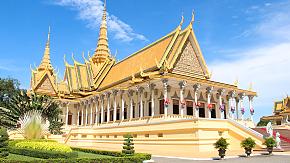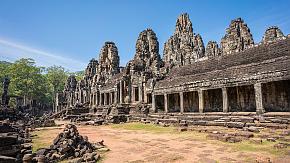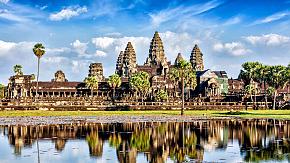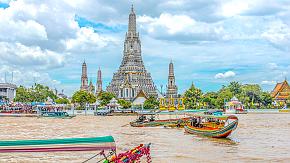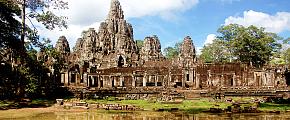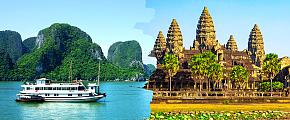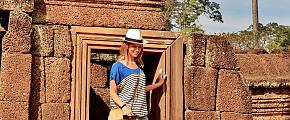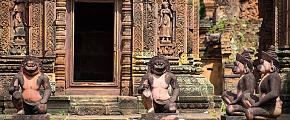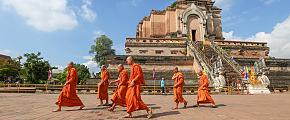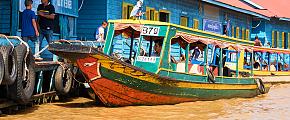Useful Things to Know for Traveling to Cambodia
Cambodia is one of those countries many travelers have on their bucket list. There are spectacular temples, more than just Angkor Wat; and from the lush jungles to beautiful coastline, a developing gastronomy scene to a lively nightlife, this country is full of amazing sights waiting for your arrival. As for any holiday, it is important to be well prepared. Here is a guide with practical travel tips to tell what you may need to know for traveling to Cambodia.
Cambodia's Climate and Travel Season
Cambodia has a tropical monsoon climate with two dominant seasons in a year: dry season and wet season. It is hot and humid, with an average annual temperature of 28° C. In fact, to many travelers, the climate can be divided by three major seasons, dry season, hot season and rainy season as below.
Dry season: From November to February, there are long days of glorious sunshine and clear skies. Very little rain is seen, and it is cooler and a bit windy. It is definitely the best time of the year to visit this Buddhist country.
Hot reason: This is from March to May. These months define what the hot season is truly about. Temperatures easily reach up to 40°C.
Rainy season: the rainy season, also known as the green season, is from June to October when the countryside is alive with lush and green landscapes. Downpours rarely last more than a couple of hours but are accompanied by high humidity. Some travelers believe that this is also a great time to visit Cambodia, as the temples are quieter with smaller tourist crowds and hotels are cheaper.
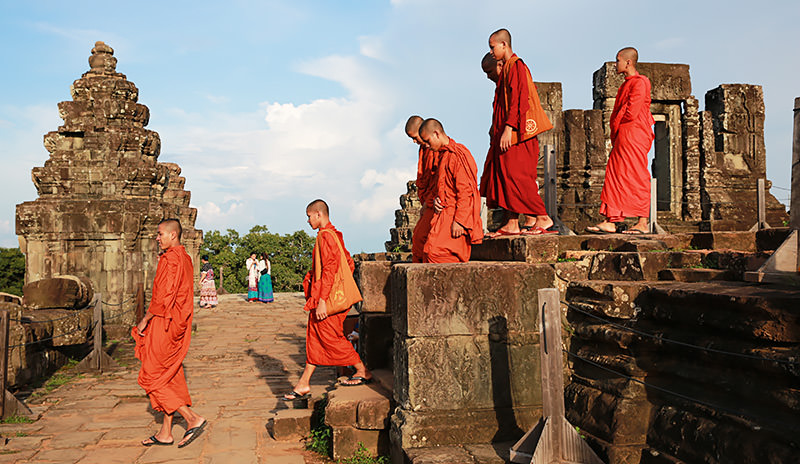 Phnom Bakheng Temple in Siem Reap, Cambodia
Phnom Bakheng Temple in Siem Reap, Cambodia
Clothing
Due to Cambodia’s tropical climate, loose-fitting, lightweight, cotton clothing would be most suitable. As for the color, white or clear colors is a good idea. Besides, a sunhat or handkerchief, sunglasses, and sunscreen are recommended as protection against sunlight when sightseeing outdoors. One more thing to remember is that comfortable, soft-soled walking shoes are essential.
Dress code for visiting religious sites: When visiting sacred sites, including those of the Angkor complex, it is important for both men and women to dress modestly, covering shoulders and legs to at least the knee. Footwear and headgear are generally removed at the entrance before entering temples or pagodas.
Tips:
The northern region can be a bit colder during the cool season. A sweater or a light jacket might be needed if you intend to visit this region at the time.
Money Matters
The Cambodian Riel (KHR) is the country’s official currency; but alongside the national currency, the US dollar is also widely accepted and circulated in most places. When calculating exchange rate, US$ 1 is usually rounded off to 4000 KHR. In general, Riels are used for small purchases (cigarettes, fruit or drinks bought on a market stand, for example), whereas dollars are preferred in restaurants, hotels and supermarkets; and it is common to pay for something in US dollars and receive change in riels.
Credit-card-compatible ATMs (Visa, MasterCard, JCB, Cirrus) can be found in most major cities. ANZ Royal Bank has the most extensive network, followed by Canadia Bank, Cambodian Public Bank, and SBC Bank. There are options of withdrawing in U.S. dollars or Riel. A service fee of about US$5 per transaction will be charged on most ATM withdrawals.
Tips:
1. We recommend you take a mixture of cash (preferably USD) and credit/debit cards for ATMs.
2. It is best to carry U.S. dollars in small denominations, as it can sometimes be hard to get change from large notes.
3. The locals may refuse to accept slightly torn or excessively damaged bank notes, so it is advisable to have them in relatively good condition.
4. Avoid using ATMs in remote areas; and stay alert when using ATMs late at night.
Communications
Travelers can purchase pre-paid SIM cards, with the prices ranging from $1 to $5, at the airports or border checkpoints on arrival. Additional value cards, available in values between US$2 and US$100, can be bought to add money to the SIM card. The five major mobile phone service providers in Cambodia are MobiTel, Beeline, Smart Mobile, Cube, and MetFone.
Free Wifi is available in most hotels, restaurants and cafes of major tourist cities, like Phnom Penh and Siem Reap. In the rural areas of the country, internet access is limited.
Tips:
1. It is required to show your passport when buying pre-paid SIM cards.
Dining
Cambodian food, or Khmer cuisine, has been heavily influenced by its neighbors, Thailand, Laos and Vietnam. Rice, noodles, soups, curries, and stir-fried vegetables are the staple diet of the locals. Traditional dishes include Amok, Nom Banh Chok, Bai Sach Chrouk, Cha Houy Teuk, Fried Crab, etc.
Western-style restaurants or cafes can be found in major tourist cities like Siem Reap and Phnom Penh. Some of them also offer Asian cuisine to widen your meal choices.
Tips:
1. Street food seems to be quite inviting (except the scary part), but you'd better look out whether it's clean or not.
2. Sometimes drink can cost more than food. Check the price before you order.
Safety
Cambodia is now a safe place for travel. Violent attacks are super rare. Petty theft is the most common type of crime here, and be aware of some scams, like taxi/tuk-tuk scams. You might occasionally meet a driver who works under commission for a particular restaurant, hotel, etc.
Tips:
1. Handbag snatches/theft from motorbikes occur especially in the larger cities as Phnom Penh. Please carry your handbag or rucksack to the front of you.
2. Some essential advice is to purchase good travel insurance, which can protect you against illness, injury, theft, and cancellations. It's comprehensive protection in case anything goes wrong.
Health
Vaccinations: It is important to stay healthy when you're on vacation. In Cambodia, although there are no compulsory vaccinations, it is advisable to be immunized against hepatitis A, tetanus and diphtheria. Please consult your doctor for the most up-to-date advice about vaccinations, although there are no compulsory vaccinations.
Drinking water: Tap water should never be drunk considering the risk of water borne diseases. Purified, bottled water is widely available in stores, hotels and restaurants and the price is very low. Be cautious when buying bottled water at street stalls or near attractions, and make sure the cap is sealed.
Mosquito repellent: Use an insect repellent to avoid mosquito bites throughout the day. It is the only way to be sure of protection against mosquito-borne diseases.
Local Etiquette
Meet and Greet: Learn the Cambodian greeting, known as Sampeah. Cambodians will place both palms together in front of their chest and bow their head slightly. Depending on the person who is on the receiving end, Sampeah is divided into five categories with hands placed at different level: chest level is for friends, mouth level for bosses or anyone high ranking, nose level for parents, grandparents and teacheres, eyebrow level for the King or monks, forehead level at the highest when praying to God or other sacred figures.
Table manners: Don't leave your chopsticks sitting vertically in a rice bowl as it looks like the incense sticks that are burned for the dead. This is a powerful sign and is not appreciated anywhere in Asia.
Religion and Tradition: Be sensitive about traditions and pay respect to religious beliefs. 1). Always remove your shoes before entering a temple or a house. 2). Never point your feet towards anything sacred or towards other people. 3). Monks are not supposed to touch or to be touched by a woman. 4). Avoid hugging and kissing in public.
Tipping
Tipping is not customary but often expected in Cambodia. You are welcome to offer additional gratuities as a sign of appreciation for services. For your guide and driver, the amount of tip depends on how you rate their service. As a guideline, we suggest $5~10 per day for your guide and half of that for your driver.
Photography
Cambodia is an incredible place to photograph. But like almost everywhere, it should be carried out with respect to the local culture.
People: It is always polite for you to ask permission before photographing local people (particularly monks), unless you are shooting a crowded public scene. Please be considerate a smany people don't like being taking off-guard with a photo.
Religious sites: Be aware and respectful when photographing religious sites. Photography in temples is usually also not a problem. Still, always double check the entrance for signs either allowing or prohibiting photography; and it is always advisable to ask before photographing monks. Also, selfies at certain religious sites can also be seen as disrespectful.
Border/military control zones: Photography at border crossings and near any military installations is prohibited. Also, avoid taking photograph of military or police personnel.
Cambodia should definitely be on your travel to-do list. Don't hesitate in spending a few rewarding days in this amazing country. Please feel free to contact us and together we can create a personalized tour exclusively for you.
Related Posts You May Like
What Our Clients Say
Explore the latest verified reviews of Odynovo's travel services on Tripadvisor, Google, Trustpilot, Product Review and more trusted platforms.

